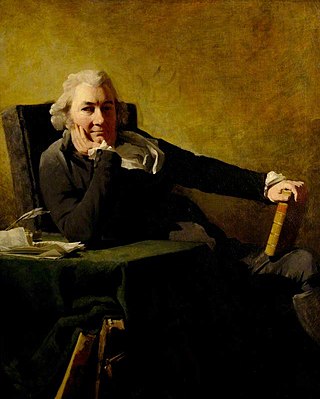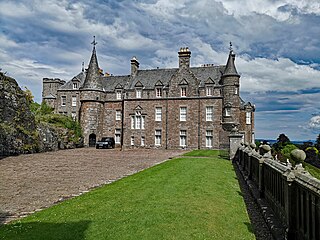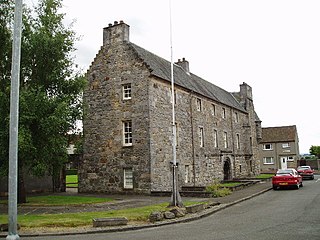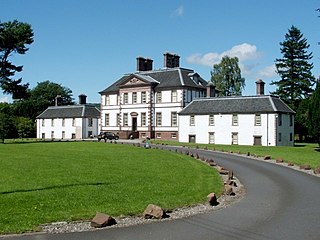
Robert Bontine Cunninghame Graham was a Scottish politician, writer, journalist and adventurer. He was a Liberal Party Member of Parliament (MP); the first ever socialist member of the Parliament of the United Kingdom; a founder, and the first president, of the Scottish Labour Party; a founder of the National Party of Scotland in 1928; and the first president of the Scottish National Party in 1934.
Whithorn ([ˈʍɪthorn]) 'HWIT-horn'; Taigh Mhàrtainn in Gaelic), is a royal burgh in the historic county of Wigtownshire in Dumfries and Galloway, Scotland, about 10 miles (16 km) south of Wigtown. The town was the location of the first recorded Christian church in Scotland, Candida Casa : the 'White [or 'Shining'] House', built by Saint Ninian about 397.

Robert Graham, who took the name Bontine in 1770 and Cunninghame Graham in 1796, was a Scottish politician and poet. He is now remembered for a poem If doughty deeds my lady please, which was later set to music by his great-great-grandson, Rev. Malise Cunninghame Graham and also by Sir Arthur Sullivan.

Auchinleck House is an 18th-century mansion in Scotland. It is situated near the town of Auchinleck near Cumnock and Ayr in East Ayrshire. The Auchinleck Estate has been inhabited since the 13th century, and the remains of Auchinleck Castle and Auchinleck Old House stand in the estate. The house is protected as a category A listed building, while the two ruined dwellings are scheduled monuments.

Drummond Castle is located in Perthshire, Scotland. The castle is known for its gardens, described by Historic Environment Scotland as "the best example of formal terraced gardens in Scotland." It is situated in Muthill parish, 4 kilometres (2.5 mi) south of Crieff. The castle comprises a tower house built in the late 15th century, and a 17th-century mansion, both of which were rebuilt in Victorian times. The gardens date to the 1630s, although they too were restructured in the 19th century. The formal gardens are protected as a category A listed building, and are included on the Inventory of Gardens and Designed Landscapes in Scotland. The tower house and mansion are both category B listed.

St. Ninians is a long-standing settlement which is now a district of the city of Stirling in central Scotland. It is located approximately one mile south of the city centre. It was originally known as Eccles, and may have been a Christian site from an unusually early date. Later called 'St. Ringan's'. This church was the administrative centre for churches across the strath of the River Forth.

Sir John Ninian Comper was a Scottish architect; one of the last of the great Gothic Revival architects.

St. Ninian's Cathedral, Perth is a cathedral of the Scottish Episcopal Church in the Diocese of St Andrews, Dunkeld and Dunblane.

Herbert Robin Cayzer, 3rd Baron Rotherwick, is a British landowner and estate manager. He sat as a hereditary peer in the House of Lords for the Conservative Party, from 1996 until his retirement in 2022.

The Cunninghame Graham Memorial is a stone monument dedicated to the memory of 'Don Roberto' Robert Bontine Cunninghame Graham (1852–1936) 15th of Gartmore and 19th of Ardoch, a Scottish author, politician, traveller and horseman.

Menstrie Castle is a three-storey manor house in the town of Menstrie, Clackmannanshire, near Stirling, central Scotland. From the early 17th century, it was home to Sir William Alexander, 1st Earl of Stirling, who was instrumental in founding the colony of Nova Scotia. It was later owned by the Holburn or Holborne family, who were created Baronets of Menstrie in 1706. The castle was restored in the 20th century, won a Civic Trust award, and now incorporates holiday accommodation, private flats, and a museum and cafe run by the National Trust for Scotland.

Sir Charles William Cayzer, 1st Baronet was a British businessman and Conservative Party politician.

Carberry Tower is a historic house in East Lothian, Scotland. The house is situated off the A6124 road, 2 miles (3.2 km) south-east of Musselburgh. Carberry, like Musselburgh is in the parish of Inveresk. It is protected as a Category B listed building.

Stobo Castle is located at Stobo in the Scottish Borders, in the former county of Peeblesshire. The Manor of Stobo was originally owned by the Balfour family. It became the family seat of the Graham-Montgomery Baronets from 1767. The building of the present castle began in 1805 and was completed in 1811 under the supervision of architects Archibald and James Elliot. It is currently operated as a health spa. The house is protected as a category A listed building, while the grounds are included in the Inventory of Gardens and Designed Landscapes in Scotland, the national listing of significant parks and gardens.

Finlaystone House is a mansion and estate in the Inverclyde council area and historic county of Renfrewshire. It lies near the southern bank of the Firth of Clyde, beside the village of Langbank, in the west central Lowlands of Scotland.

Gillis Centre, formerly Gillis College and founded as St Margaret's Convent and School, is a complex of buildings situated close to the city centre of Edinburgh, Scotland. The history of the site can be traced back to the 15th century. The original building housed many literary figures of the eighteenth century, from 1834 it served as a convent and from 1986 to 1993 it was Gillis College, the seminary for the Roman Catholic Church in Scotland. It currently provides offices for the Curia of the Archdiocese of St Andrews and Edinburgh.

Strathleven House is an early 18th-century country house in West Dunbartonshire, Scotland. It is located in the Vale of Leven, around 3 kilometres (1.9 mi) north of Dumbarton. Built in 1700, it is probably the work of the architect James Smith, and has been described as "the earliest surviving example of the classic Palladian country house in Scotland". Strathleven House, and its 18th-century dovecote, are protected as category A listed buildings,

Kinpurnie Castle is a stately home located 12 miles (19 km) west of Dundee, close to Newtyle, near Blairgowrie, Angus in Scotland.

St Ninian's Chapel in Braemar, Aberdeenshire, Scotland, is a Grade B listed Anglican chapel located in the grounds of the Mar Lodge Estate. Built from 1895 to 1898 for use as a private chapel by the family of Alexander Duff, 1st Duke of Fife, owners of Mar Lodge, it has been the property of the Diocese of Aberdeen and Orkney in the Scottish Episcopal Church since 1899. St Ninian's Chapel is the most westerly church in the Diocese.
Stephen Adam (1848–1910) was a 19th/20th-century Scottish influential stained glass designer. He was a pioneer of modern stained glass in Scotland. The majority of his work is in the Pre-Raphaelite style, often with a twist towards Celtic mythology, and is mainly sited in western Scotland. Although the bulk of his work is for churches he also received many secular commissions.




















